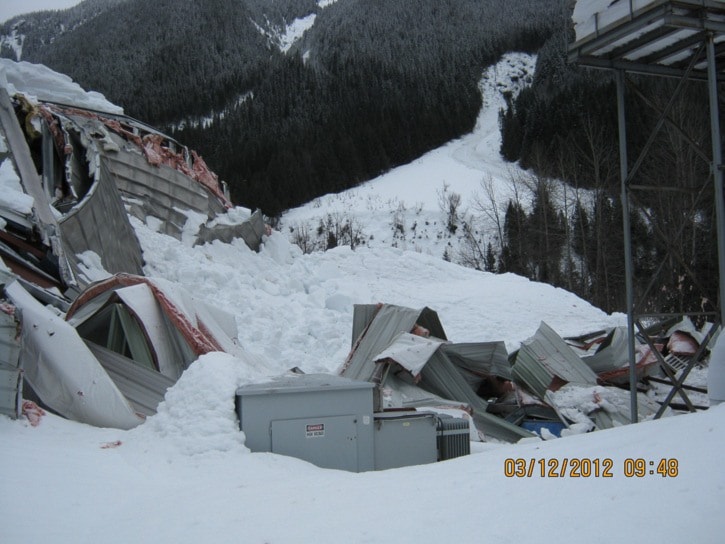The old Revelstoke Water Bottling Plant near Albert Canyon collapsed earlier this month – done in by this winter’s snow. Though how exactly it came down is a question mark.
“It was an avalanche,” said Merv Krywa of Revelstoke Property Management, who inspected the building after it collapsed.
“That was not the case,” said Sylvain Hebert of Storm Mountain Technical Services, the contractor who does avalanche control for CP Rail.
The bottling plant came down sometime before March 10. It was closed down in September 2009 and has been empty since then.
When the I first heard about it, I thought it would make for a good picture and that’s about it. When I was told it was knocked down by an avalanche, I couldn’t believe it. I couldn’t imagine they would have built a factory where people worked for close to 20 years in an avalanche path – even an infrequent one.
I took a look at Google Earth and sure enough there is an avalanche path that comes down several hundred metres from the plant, on the other side of the Illecillewaet River.
I was given some pictures of the site that showed twisted metal beams and flattened walls mixed in with lots of snow. Some of the pictures showed the slide path but there was no overarching picture showing the whole area, making it difficult to make an assessment. Unfortunately, road closures and other commitments prevented me from visiting the site myself so I asked around and eventually ended up talking to Jim Bay, the manager of AvaTerra, which used to do the avalanche control work for the railway.
“There’s no question a slide could affect that plant,” he told me. “The plant has been affected in the past. There has been some very heavy dust plastering from avalanches all over the plant.”
He said that when he did control work for the railway, he questioned doing avalanche control on that slide path because of the potential to impact the plant.
“It’s definitely in range of a slide path – a one-in-every-75-year return period, that’s the calculated thing,” Bay said. “It’s possible given the recent avalanche activity that we had and it would be very interesting for someone to take a look at it.”
He then told me to call Hebert. When we spoke, Hebert said he had been to the area recently and that the nearby avalanche path had slid, but it came down several hundred metres away.
“That’s why I say with confidence that it was not an avalanche that collapsed the building, although I can’t say for sure because I wasn’t there when the avalanche ran,” he said.
The slide that came down was a wet one, he told me, which was unlikely to produce enough of an air blast or powder cloud to take out the plant. “It leads me to believe that the building collapsed from the weight of the snow more than from an air blast from an avalanche.”
As I said, I was unable to verify his assertion myself and Krywa insisted that an avalanche hit the building, adding it survived last year’s much heavier snow load.
Ice River Springs, which owns the building, is conducting an assessment of the site.
The company is reponsible for the clean-up and Cory Legebokow from the Ministry of the Environment said he had not been contacted about any environmental issues from the buildings collapse.
“I don’t suspect there’s any issue out there other than them losing their building,” he said.
The property is for sale.
